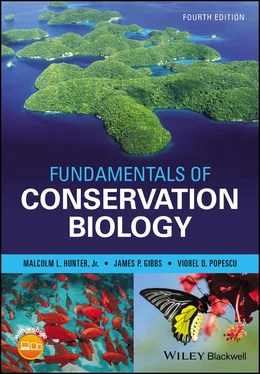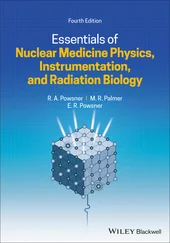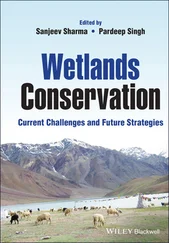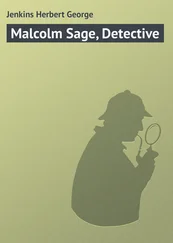Sometimes, our feelings for other species are revealed in the ways we spend our money; sometimes, they are not. Imagine a woman who lives her whole life in landlocked Kazakhstan who will never see a living blue whale, but who derives pleasure from simply knowing that blue whales exist. Her love for whales is real and valuable, but costs her nothing. It is hard for society to account for feelings like hers when making policy decisions because economic issues are usually paramount, and her feelings are not easily expressed in monetary units. But this does not make her feelings unimportant. It also does not diminish the political impact of her feelings. For example, the decision to curtail exploiting Newfoundland’s baby harp seals for their fur was made not because it was unsustainable (harp seals are doing well) but because of the deep feelings of people who had no direct contact with harp seals and no economic stake in their fate. Economists are trying to devise methods for estimating the monetary value of blue whales and harp seals for people whose only relationship with them is knowing that they exist; we will discuss existence values further in Chapter 16, “Economics.”
Scientific and Educational Values
The world is a complex place, but our knowledge of it is increasing all the time, and some of the credit goes to our fellow inhabitants ( Fig. 3.9). There are many examples. Birds offered both the inspiration to fly and a model from which to learn, and, similarly, the ability of bats to fly in the dark inspired the development of sonar and radar. Mendel’s famous peas opened the door to genetics, and the convenience of working with Drosophila fruit flies has greatly facilitated genetic research. Much of what we know about human developmental biology we learned from watching salamander eggs. Many anthropologists who seek insight into human social interactions study our nearest relatives: all the other members of the primate order. Engineers, biologists, and others continue the quest to develop technology inspired or informed by nature, an endeavor often called biomimicry (Harman 2014). Some of the latest examples are manifested at the atomic and molecular scale with the structure of viruses and bacteria furthering advances in nanotechnology (Pacheco‐Torgal and Jalali 2011) ( Fig. 3.10).
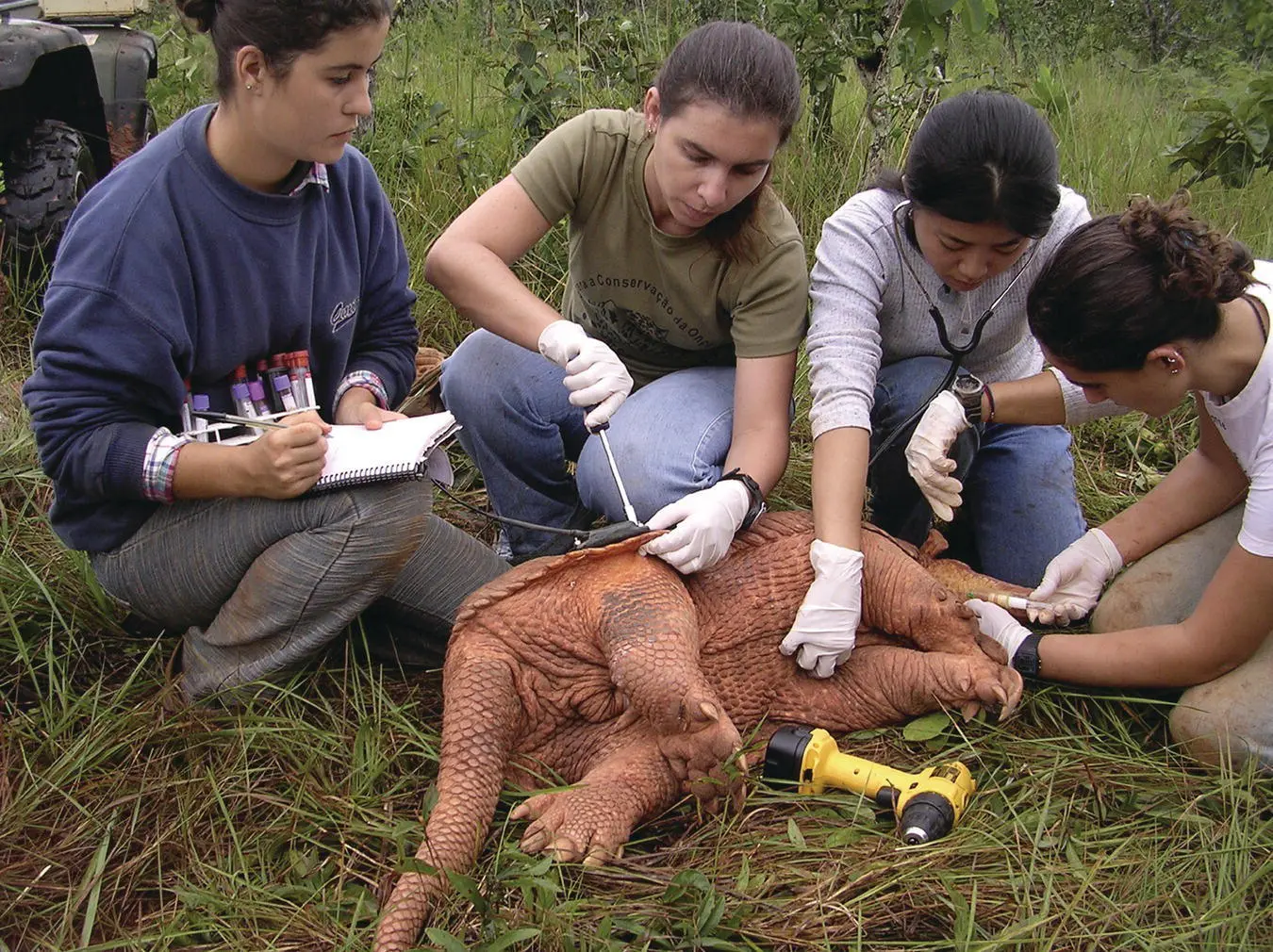
Figure 3.9 Other organisms teach us about our world. Here biologists attach a radio‐transmitter to a giant armadillo in Emas National Park Brazil.
(Courtesy of Leandro Silveira)
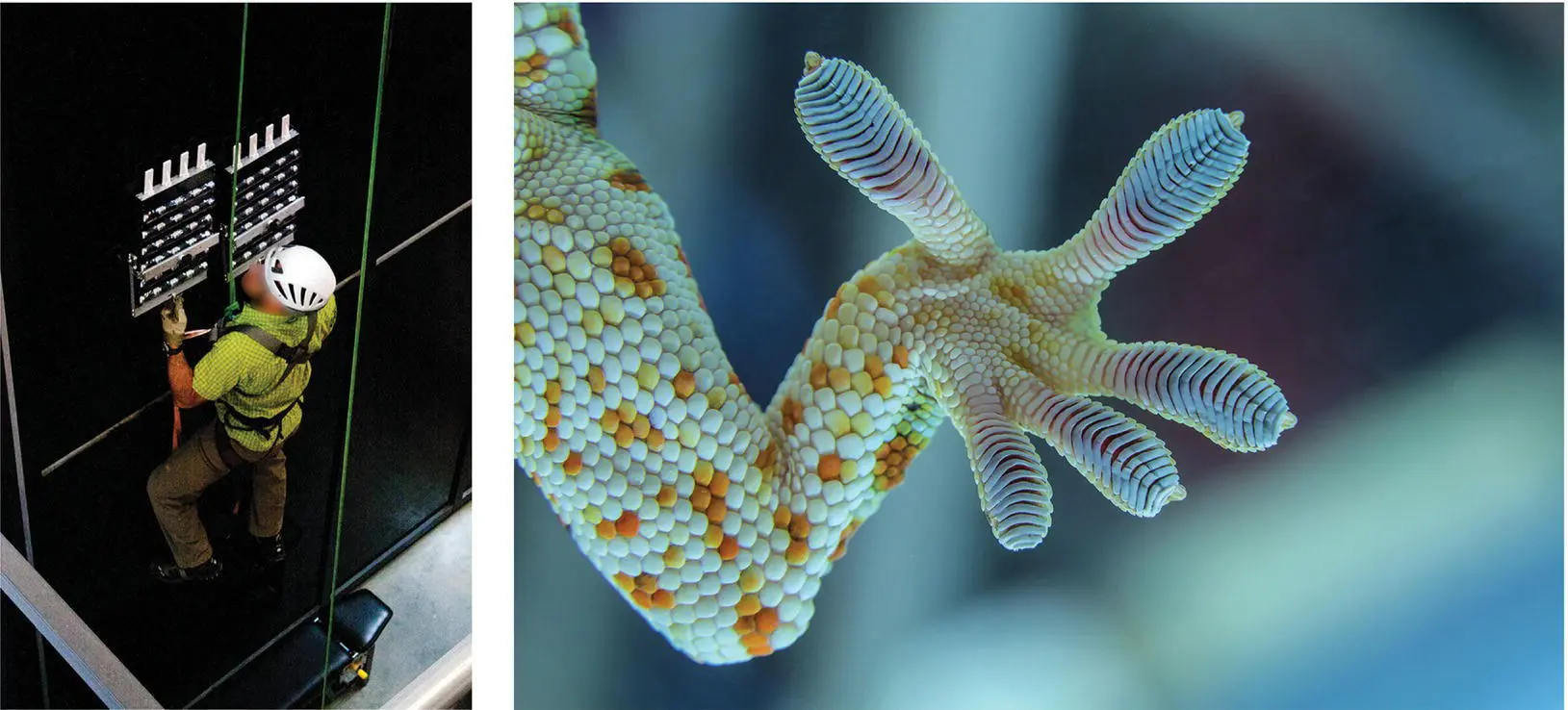
Figure 3.10 ( Left ) This person climbed up and down almost 10 m of glass, at times carrying a 20 kg load. How is this possible? He used hand‐held paddles made from novel polymer microstructure technology inspired by the toes of geckos. ( Right ) Geckos can climb smooth surfaces because their toes have bundles of “hairs” that stick to the surface by essentially sharing electrons with it. This nano‐scale technological innovation has many potential applications, from simple jobs like replacing car windshields to capturing space junk or replacing ropes and ladders for rescue operations in urban environments.
(DARPA/Public domain [ Left ]; Mr.B‐king/Shutterstock [ Right ])
Of course, scientific inquiry is just an advanced form of the intellectual curiosity about the world that begins in infancy. Our education would suffer greatly without a diverse world to explore, without bean seeds to plant and follow to germination, without frog eggs to watch develop into tadpoles. Whether we want to learn about ourselves or the world we share with other species, we need models to observe.
Every population of every species is part of an ecosystem of interacting components, and thus has an ecological role to play. There are producers, consumers, decomposers, competitors, dispersers, pollinators, and more. In this sense, every species has ecological value, that is, instrumental use to other species that share the same ecosystem, including people.
Although all species have ecological roles, not all have roles of equal importance. Some species are ecologically important simply because of their great abundance. Often these are called dominant species, a term that usually implies that they constitute a large portion of the biomass of an ecosystem. Examples are sugar maples in a sugar maple forest or various species of planktonic copepods in many marine ecosystems. Sometimes, they are called controller species, which implies that they have major roles in controlling the movement of energy and nutrients. This would include dominant species such as sugar maples and various copepods, as well as many species of invertebrates, bacteria, and fungi that are important decomposers but may not have much biomass.
Some species play critical ecological roles that are of greater importance than we would predict from their abundance or biomass; these are called keystone species (Power et al. 1996). The classic example of a keystone species is the purple sea star, an intertidal predator that preys on several species of invertebrates, apparently allowing many species to coexist without any one species becoming dominant ( Fig. 3.11). After these sea stars were experimentally removed from a rocky shore in the state of Washington, the population of one prey species, the California mussel, dominated the site, and the system shifted from 15 species of invertebrates and macroscopic algae to only eight species (Paine 1966). Most of the textbook cases of keystone species are animals. Some of them are predators like the sea star; some of them are “engineers” that create structures important to other species, such as the cavities of woodpeckers and burrows of tortoises that provide shelter for many species (Remm and Löhmus 2011) or the dams of beavers that create sizable new ecosystems and habitat for hundreds of other species and affect whole landscapes by trapping sediment and nutrients (Puttock et al. 2018) ( Fig. 3.11). For an example of a keystone plant species, consider those species, like strangler figs, that produce abundant fruit during a season when only a few plant species bear fruit, making them a critical resource for all the obligate fruit‐eating animals (Shanahan et al. 2001; Watson 2001).
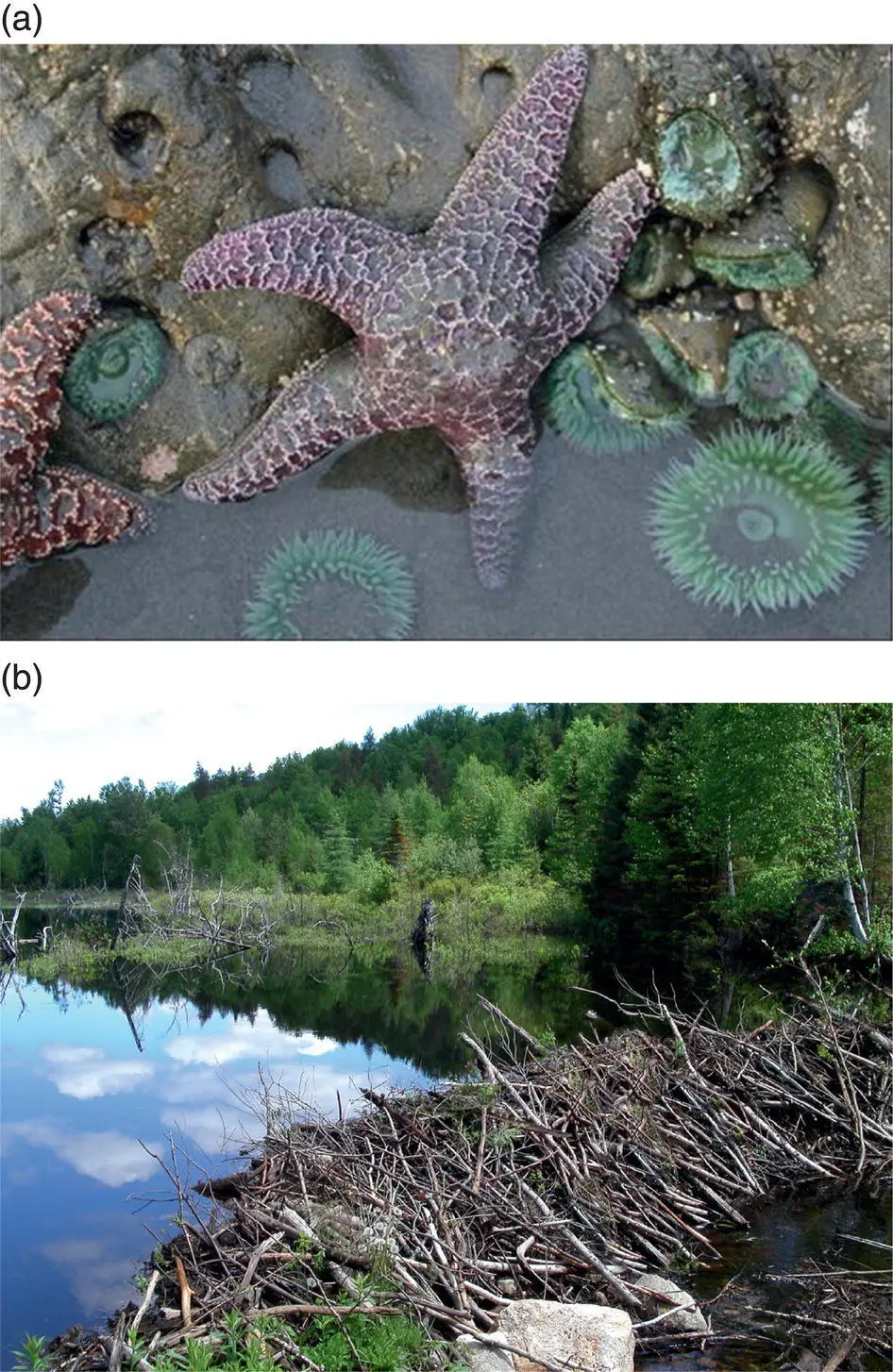
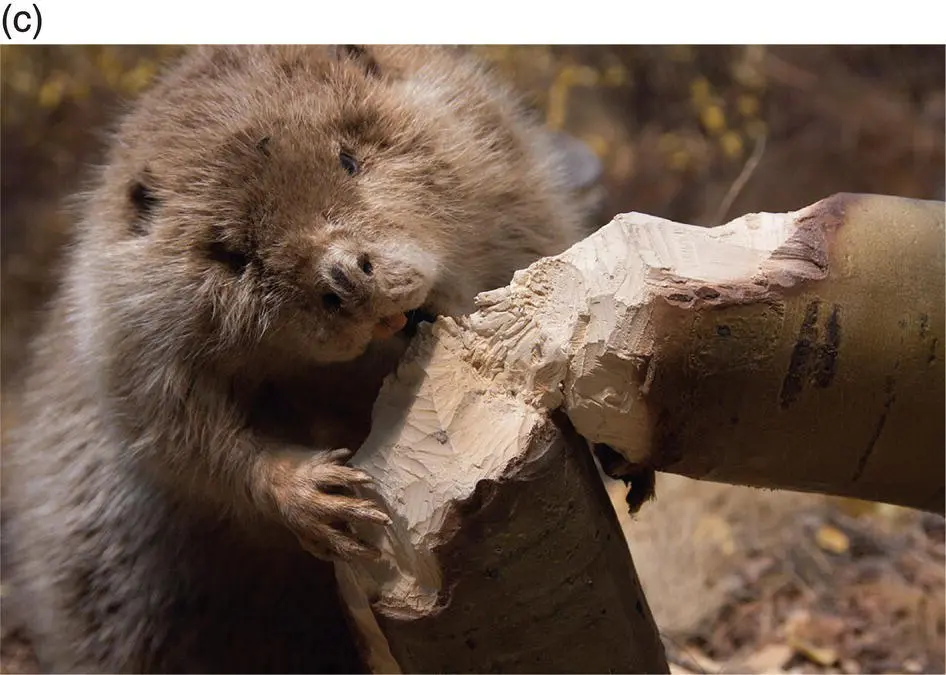
Figure 3.11 The ecological impacts of keystone species take many forms. The purple sea star (a) is a keystone species because its predatory activities allow many species to coexist, while beavers (b) shape entire communities because of flooding by their dams (c).
([a] Olympic National Park/Flickr/Public domain; [b] Hubert/Shutterstock. [c] Procy/Shutterstock)
As a rule, conservation biologists tend to focus more on the population health of keystone species than dominant or controller species because many keystone species are uncommon, whereas, by definition, dominant and controller species are relatively abundant. Of course, being abundant does not mean that these species are necessarily secure from population crashes. Many island plants have gone from being ecological dominants to being far less common following the introduction of exotic herbivores or competitors (Cole and Litton 2014). Even continental species have plunged from dominance to rarity in a short period; such was the case for the American chestnut (once 20% of the trees in eastern North America, now essentially gone) following invasion of an exotic fungus disease. Consequently conservationists should play close attention to all species that are highly interactive, both keystones and dominants, because changes in their populations affect entire ecosystems (Soulé et al. 2003). Indeed, some conservationists use the term “ ecological extinction ” if a species becomes too rare to fill its role in an ecosystem, a term that applies to many large animal species today (i.e. those that are still present but in greatly diminished numbers, like American bison).
Читать дальше
